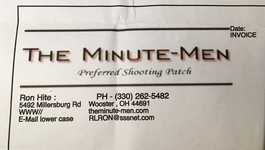@HighUintas and
@RockAndSage
I have been on ALR forum quite a bit reading. Appreciate the info. I’ve looked hard on ALR and MZ forum for info, but as you say there doesn’t seem to be much, and generally there is often a negative reaction/response to people asking about increasing range/speed/etc. Not a big deal.
That's unfortunate you're getting that kind of reaction. Maybe it's ground that just needs to be re-ploughed, without preconceived notions. I'd enjoy seeing what you could do in dialing in a flintlock.
The question of building up and accurizing a load brought back a few 35 year-old memories from when I worked up my competition load in my teens, for a percussion rifle. I'll share what I remember, hopefully there might be some tidbits that could be good reference.
Overall, I got my group sizes down to about 4 inches at 100 yards, which wasn't bad. Loads were worked up in 5 grain increments, settling on a charge of 65gr - which was definitely on the lighter side compared to the charges most people shot out of a .54cal, with patched round-ball. Zero idea on velocities, we couldn't have afforded a chrono then. But consistency was a huge part of the accuracy I got, and we were shooting at steel, so terminal ballistics weren't a concern either.
I experimented with patches quite a bit - this yielded probably half of my accuracy imporovements, but it ran counter to what was considered normal back then. I can't remember the exact thickness, but what I found worked best was
not the tightest combo of patch and ball, which was contrary to what I'd expected was necessary. Guys at the National Muzzleloading Rifle Championships had been written about using mallets on their starters, and using steel ramrods to drive home bullets over thin patches. But I found that the harder the start for me (even without using a mallet), the more bullet deformation was visible after using the small nub on the starter. And the poorer the accuracy came with it.
So, bullet deformation began being something I focused on.
That led to experimenting with how hard I seated the bullet over the powder at the very bottom. How you load with the ramrod
does matter. I couldn't come up with any kind of specific, measurable force on that, as I got the best results in just gently but firmly pushing the patched ball all the way down, without
striking it with the ramrod. You'll commonly see people kinda whack the bullet down with each down-motion, and also do the final seating of their ball by "tossing" the ramrod down the barrel, and finish when it kind of "bounces" back up. That bounce is a real thing, and does tell you the bullet's firmly seated over the powder - it won't bounce back in that manner until its seated firmly. But I discovered/inferred that it was also deforming my bullets, as doing that resulted in poorer accuracy for me.
Muzzleloaders need pure, soft lead, not tire weights or other harder alloyed lead (never got a good explanation why, but it's what "everybody knows", so it may also be worth questioning), and it's easy to cause deformation. I do think that I was getting good accuracy by being at the other end of the spectrum of the NMLRA competitors with patch and ball combos - I think they were deforming their balls into slugs into the rifling by malleting them, with thin patches. I got best performance by doing everything I could to keep them as round as possible.
As part of that, I discovered that narrower bullets and thicker patches worked better for me. They allowed for an easier load, but I also think they sealed better and more consistently - muzzleloader rifling tends to have lands standing out much more pronounced than on cartridge guns, and thin patches don't seem to make it to the bottom of the groove. The thinner patches also seemed to get cut up worse on the lands during loading and firing.
On a clean, swabbed barrel, the powder, patch, and ball occupies a specific volume of the bore - I marked my ramrod to show exactly where that Loaded mark was. It's good standard practice, to help determine if the gun is loaded, if you dry-balled, or double-charged or double-balled too. But in my case, it was instructive about fouling volume as well. After about 3 rounds, that gentle/firm "push" seating not only became harder, but that ramrod mark would be a bit above the muzzle of the barrel, which was the extra fouling occupying that bore that got pushed down beneath the ball. By swabbing the bore with a couple of cleaning patches covered in alcohol after every 3rd round, it kept loading easy for that firm push, and kept accuracy and consistency higher. Beyond that between swabbings and it just required more force, and got poorer accuracy.
The final tip that's coming to mind is a bit of arcana, but I did find that I did seem to get a slight bump in accuracy by making sure the weave of the patch material was running in the exact same direction every time.
If I were to take up this challenge again, the most interesting areas to experiment with would be different patch materials, different patch lubes, wad patches between powder and bullet-patch, and harder bullets. There's a lot that can be experimented with while being strictly period-correct, but straying out that a bit could also yield some interesting results.


